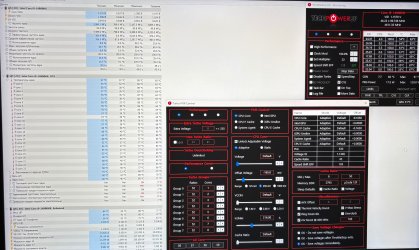This screenshot was also shown to show that those two cores, where the larger multiplier is shown, were the ones that were heating up more for me.
The ability to slow down your one hot running core
It is not necessary to limit the performance of the core that is heating up (if we are talking about the best core marked by intel, that what comes with the biggest ratio). As I already mentioned, you can simply set a higher Ratio for the cooler cores, and then Windows will consider them the best cores. For example, run a CPU stress test and find the two cores with the lowest temperature, then set their Ratio to 58 and set the Ratio for the other cores to 56.
Although I’m not sure if the other cores can reach 5.8 GHz, I think they might. If not, you'll have to set the Ratio to 56 for the cooler cores and 55 for the rest. But in any case, this will not affect multi-threaded performance at all. Even single-threaded performance won’t be affected much since reaching 5.8 GHz is almost impossible due to temperature throttling.
@unclewebb Today, I reinstalled Windows, and naturally, the first thing I installed was TS and MSI Center. The first thing that caught my eye was that MSI Center no longer changed the MMIO PL1 and PL2 values they remained the same as the MSR values. At first, I was happy and went ahead with testing, but to my surprise, I was limited to 55W TDP in Balanced mode and 75W TDP in Performance mode (such a limit when nvidia gpu works at full).
Previously, I could reach 140W TDP even in Discrete Graphics mode, and exceed 140W in MSHybrid mode when the NVIDIA GPU wasn’t consuming much power. Now only the Integrated Graphics mode allowed me to go beyond 75W. At first, I reset the BIOS, thinking I had messed something up, but that wasn’t the case...
Long story short, it turned out that this was controlled not by MSI Center but by the Intel IPF Driver and Intel Dynamic Tuning Driver. After installing them from MSI’s website on my laptop’s support page, I was once again able to exceed 75W TDP in Discrete Graphics and MSHybrid modes.
I even came across this page:
https://www.intel.com/content/www/us/en/support/articles/000090464/graphics.html
It seems that for some manufacturers, disabling Dynamic Tuning removes the limit, which is probably why this page exists on Intel’s website. but I didn't have it turned off, I just had the standard drivers from Microsoft. I might try this before my next windows reinstall:
https://www.reddit.com/r/Dell/s/xKoSs4JbcW
 www.techspot.com
www.techspot.com




